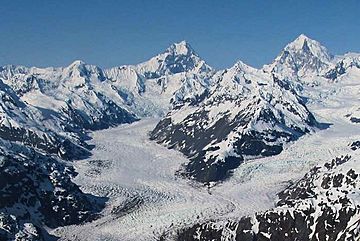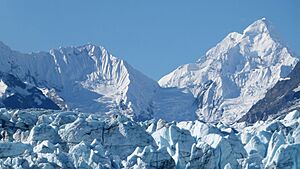Mount Salisbury facts for kids
Quick facts for kids Mount Salisbury |
|
|---|---|

Mount Salisbury centered in the distance
|
|
| Highest point | |
| Elevation | 12,170 ft (3,710 m) |
| Prominence | 3,970 ft (1,210 m) |
| Geography | |
| Location | Glacier Bay National Park and Preserve, Alaska, U.S. |
| Parent range | Fairweather Range |
| Climbing | |
| First ascent | 1977 by J Nelson, S Swenson, J Eberharter, G Thompson |
| Easiest route | glacier/snow/ice climb |
Mount Salisbury is a tall mountain peak located in the Fairweather Range in Alaska. It stands about 6 miles (10 kilometers) southeast of the even taller Mount Fairweather. This mountain is part of the amazing Glacier Bay National Park and Preserve.
The eastern slopes of Mount Salisbury feed into a branch of the huge Johns Hopkins Glacier. This glacier then flows all the way into Glacier Bay. On the western side of the mountain, there's a big bowl-shaped area called a cirque. This cirque is shared with other famous mountains like Mount Fairweather, Mount Quincy Adams, and Lituya Mountain. From this cirque, the Fairweather Glacier begins its journey, almost reaching the Pacific Ocean near Cape Fairweather.
Contents
What Makes Mount Salisbury Special?
Even though Mount Salisbury isn't the highest mountain around, it's very impressive because of how much it drops from its peak to the land below. This is called "vertical relief." For example, the southwest side of the mountain plunges over 10,000 feet (about 3,000 meters) down to the Johns Hopkins Glacier in just five miles! Imagine looking down from that height!
Why Isn't Mount Salisbury Climbed Often?
Mount Salisbury is not a popular mountain for climbers, and there are a few reasons why.
Is Mount Fairweather a Factor?
One reason is that it's very close to Mount Fairweather, which is much taller and more famous. Many climbers choose to tackle Mount Fairweather instead.
What About Access and Weather?
Another big reason is that it's quite hard to get to Mount Salisbury. The area is remote and rugged. Plus, the weather in the Fairweather Range is often very bad. It can be stormy, foggy, and very cold, making climbing dangerous and difficult.


